Bright and original Tbilisi can surprise tourists with its rich history, picturesque ancient architecture and extraordinary hospitality traditions that have been observed here for hundreds of years. The city also has another side – the boldly forward-looking outlines of the Bridge of Peace and the Theater of Music and Drama, modern amusement parks that meet the highest quality standards, as well as museums with current expositions.
After a walk through the old quarters of Tbilisi, tourists are happy to taste excellent Georgian wine in restaurants and enjoy savory dishes of national cuisine. The good nature of the locals is another advantage that speaks in favor of Tbilisi. Guests are always welcome here and will be happy to tell a lot of interesting things from the historical past of the city.
What to see and where to go in Tbilisi?
The most interesting and beautiful places for walking. Photos and a short description.
- Tbilisi old town
- Rustaveli Avenue
- Narikala fortress
- Tsminda Sameba
- Metekhi Temple
- Anchiskhati Church
- Zion Cathedral
- Pantheon on Mount Mtatsminda
- Flea market at the Dry Bridge
- Puppet Theater Rezo Gabriadze
- Georgian Opera and Ballet Theatre. Paliashvili
- Georgian National Museum
- Tbilisi Ethnographic Museum
- Sulfur baths (Abanotubani)
- Freedom Square and Monument
- Monument to the heroes of the film Mimino
- Monument Mother Kartli
- Monument History of Georgia
- Tbilisi Botanical Garden
- Turtle lake
- Rike Park
- Tbilisi funicular
- Amusement Park Mtatsminda
- Cable car
- Peace Bridge
Tbilisi old town
The historical part of Tbilisi, located at the foot of Mtatsminda. On the territory of the Old City there are ancient temples, palaces, mansions built in the best traditions of Georgian architecture. Many buildings have been restored and converted into restaurants, wine tasting rooms, hotels and souvenir shops. However, there is another, non-tourist part of the area, where dilapidated emergency houses huddle, in which people still live.
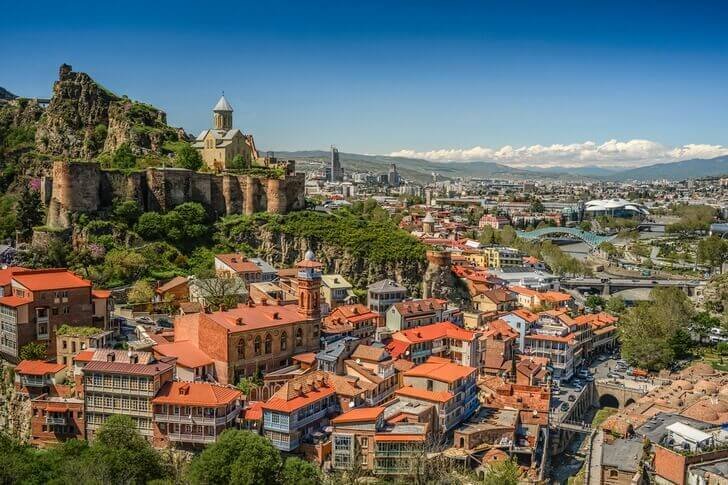
Rustaveli Avenue
The central alley of Tbilisi, stretching from the square. Freedom to sq. Rustaveli 1.5 km. The street is the center of the cultural life of the city; many sights are located here. The avenue was founded in the 19th century, the construction took place under the supervision of Prince Vorontsov, the governor of the Russian Empire in the Caucasus. Rustaveli Avenue is always very crowded, as this place is considered one of the best in the city for walking.

Narikala fortress
The first mention of the fortress dates back to the 5th century. Since the 7th century, it has been conquered more than once by the Byzantines, the Mongols, and then the Arabs. For a long time, Narikala was the center of the Georgian kingdom. A powerful fortification rises on a hilltop surrounded by sheer cliffs, which seriously impeded the enemy's access during the siege. In 1827, as a result of a powerful earthquake, the building was seriously damaged. Partial restoration was carried out in the 90s. XX century.

Tsminda Sameba
The Cathedral of the Georgian Orthodox Church, which was built in the period 1995-2004. designed by A. Mindiashvili. Given the difficult times that came to Georgia in the 90s, it was quite difficult to allocate the entire amount from the state budget, so a significant part of the money was collected through voluntary donations. Tsminda Sameba is a whole complex, which includes a monastery, a seminary, the residence of the patriarch and a cathedral.

Metekhi Temple
The church is located on the edge of a sheer cliff, which is located in the center of Tbilisi. It was erected in the 13th century on the site of the palace of the founder of the city, Vakhtang I Gorgasali. Over the next three centuries, the building was repeatedly destroyed. The temple, built in the 16th century, has survived to this day. The architecture of the church is an exemplary example of Georgian temple architecture, which is characterized by laconic forms and the absence of decorative elements.
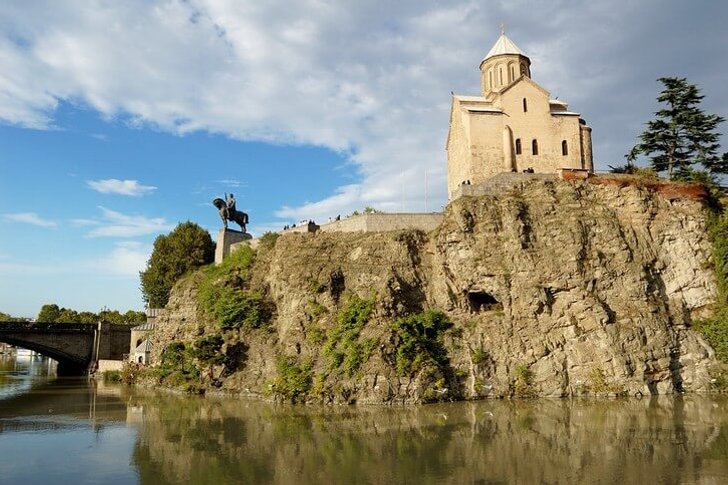
Anchiskhati Church
The church was built in the 6th century under King Dacha Ujarmeli, it is the oldest temple in Georgia that has survived to this day (taking into account the reconstruction and destruction of the 15th-17th centuries). During Soviet times, the territory of the temple was adapted for a folk craft museum and an art workshop. Now one of the best choirs of Georgia performs in Anchiskhati church. The building also houses valuable icons.
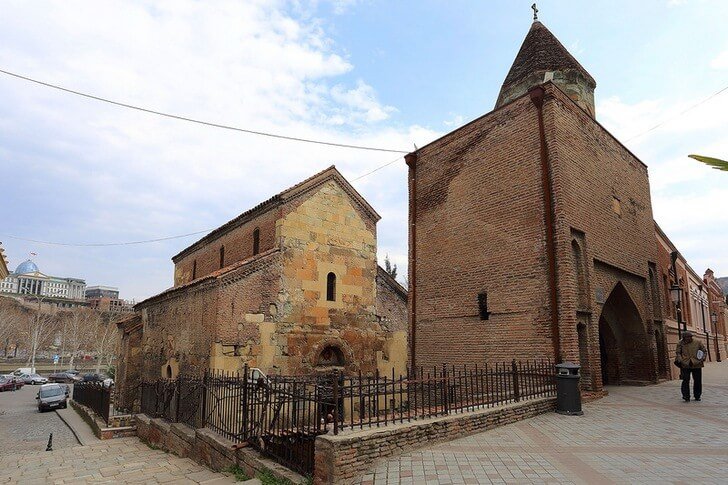
Zion Cathedral
Zion Cathedral was a cathedral until 2004. The first temple on this site was erected in the 6th century, later newer buildings appeared, in which fragments of previous buildings were used. As a result, the facade of the Sioni Cathedral turned out to be made up of stone parts belonging to different eras. The most significant shrine of the church is the cross of St. Nino, which converted Georgia to the Christian faith.
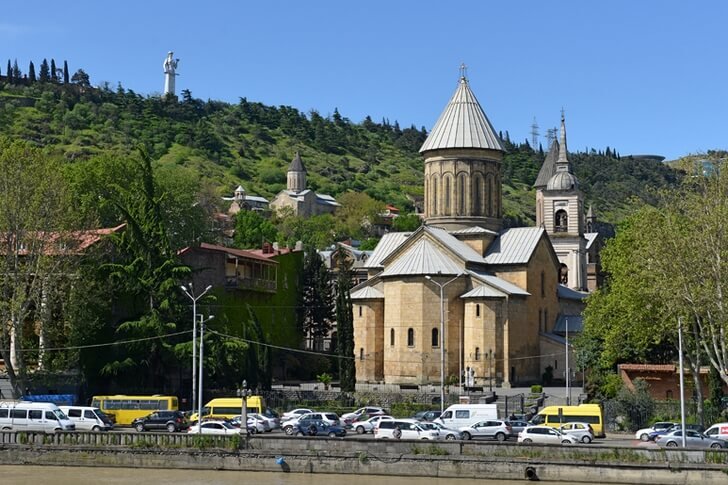
Pantheon on Mount Mtatsminda
Necropolis, where significant public and cultural figures of Georgia are buried. Scientists, writers, national heroes, famous artists are buried here. The cemetery was formed in 1929 just in time for the centenary of the death of A. Griboyedov in Iran. The remains of A. Tsereteli, S. Janashia, L. Gudiashvili, F. Makharadze and other famous personalities are buried in the pantheon. The first Georgian President Z. Gamsakhurdia is also buried here.

Flea market at the Dry Bridge
A flea market and a tourist attraction located near the bridge over the Kura River. The flea market is a cult place, every guest of Tbilisi should definitely look here. The variety of goods is amazing - they sell antique porcelain, chandeliers, Soviet posters, cameras and even rare sets of surgical instruments. The cost of some copies can reach several thousand dollars.

Puppet Theater Rezo Gabriadze
The theater is located in Old Tbilisi near the Anchiskhati Church. It was founded in 1981 by playwright, director and artist R. Gabriadze. The stage is chamber, the auditorium is designed for only 80 seats. The troupe constantly takes part in international festivals and has already managed to visit many European countries, the USA and Canada on tour. The performances of the Puppet Theater have always received good reviews from critics.
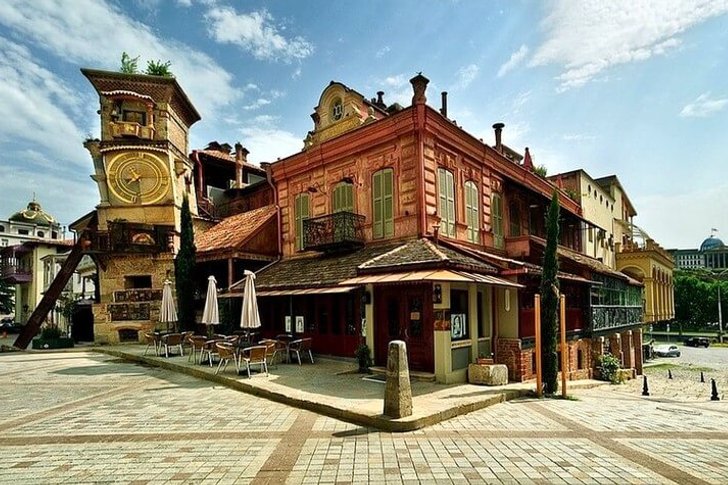
Georgian Opera and Ballet Theatre. Paliashvili
The building of the opera stage is located on the central Rustaveli Avenue. It was erected in the middle of the 19th century and, according to many contemporaries, was not inferior in beauty to the leading theaters in Europe. In 1874, the theater was destroyed by fire, after which a new building was erected, which now adorns the center of Tbilisi. Throughout the 20th century, the theater was the center of the cultural life of the Georgian capital.

Georgian National Museum
The museum is a whole network of galleries located throughout Georgia. The main branch is located in Tbilisi. The museum was founded in 2004, its funds include the collections of the Museum of History of Tbilisi, the State Museum of Arts of Georgia, the Dmanisi Museum-Reserve of History and Archeology, the Museum of Georgia named after S. Janashia and many others. The extensive exposition covers the time period from the 4th century BC. until the 20th century.
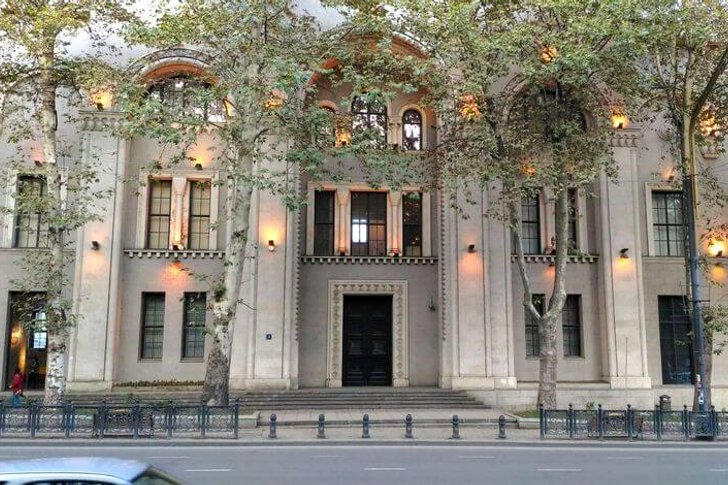
Tbilisi Ethnographic Museum
An open-air museum housing traditional Georgian houses and buildings collected from all regions of the country. The exposition was founded in 2004 thanks to the serious work of the ethnographer G. Chitay. The museum is located on a vast area of 52 hectares, its collection includes more than 70 houses and about 8 thousand historical artifacts. In addition to residential buildings, the museum has mills, wineries, a family tomb and an ancient temple.

Sulfur baths (Abanotubani)
The attraction is located in the Abanotubani region, which stretches along the course of the Kura River. Baths were erected on the site of ancient sulfur springs discovered during the reign of King Vakhtang I Gorgasal, the founder of Tbilisi. The water in the baths is supplied directly from the ground. The buildings were built of red brick and topped with round domes with windows through which ventilation is carried out. Inside the baths are lined with tiled tiles.
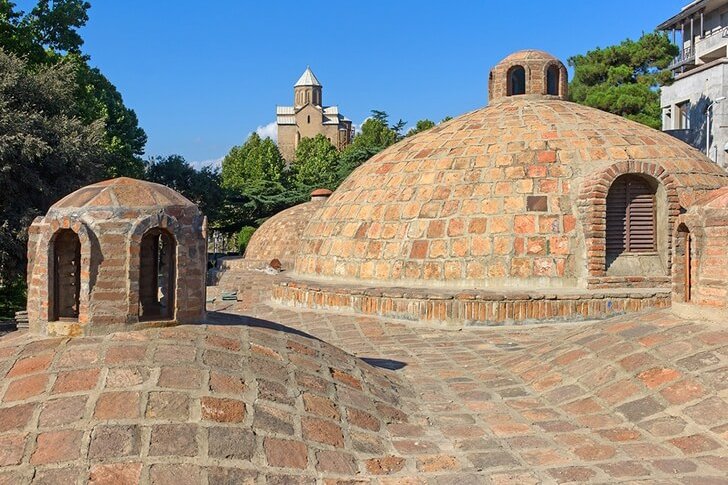
Freedom Square and Monument
The architectural ensemble of the square began to take shape in the middle of the 19th century, when the active development of Tbilisi began. During the Soviet era, dilapidated buildings were demolished and the square was renovated in accordance with the architectural traditions of that time. Today, Freedom Square is a place of concentration of administrative and government buildings. In the middle there is a Freedom Monument in the form of a 30-meter column and a statue of St. George, designed by Z. Tsereteli in 2006.

Monument to the heroes of the film Mimino
The monument was created by the famous sculptor Z. Tsereteli, it was installed in Tbilisi in 2011. in the Avlabari region. Initially, it was assumed that the sculptural group was to take place on the Patriarch's Ponds in Moscow. The monument symbolizes the friendship of the Georgian, Armenian and Russian peoples. This is what the mayor of Tbilisi spoke about at the opening of the monument in the presence of a large number of citizens.

Monument Mother Kartli
The monument is a symbol of the national character of Georgia, in which many features are intertwined. The figure of Mother Kartli symbolizes hospitality and, at the same time, readiness to defend itself from enemies. The statue was created in 1958 by sculptor E. Amashukeli for the celebration of the one and a half thousandth anniversary of the founding of the Georgian capital. The first monument was made of wood, in 1963 it was replaced with an aluminum copy.
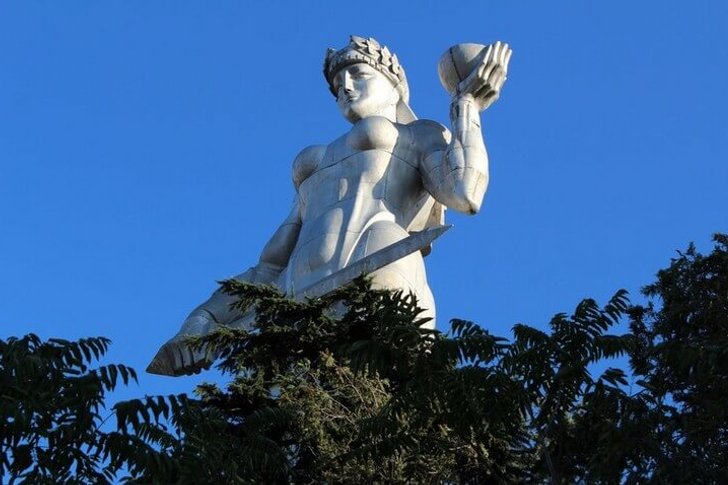
Monument "History of Georgia"
The monument is located 13 km. from Tbilisi on the banks of the Tbilisi reservoir. It is a group of 16 columns 353 meters high. Each column depicts a specific plot related to the history of Georgia or biblical scenes. The sculptural group also includes the cross of St. Nino, a church and statues of sages who contributed to the spread of Christianity. Sculptor Z. Tsereteli worked on the monument for almost 20 years.
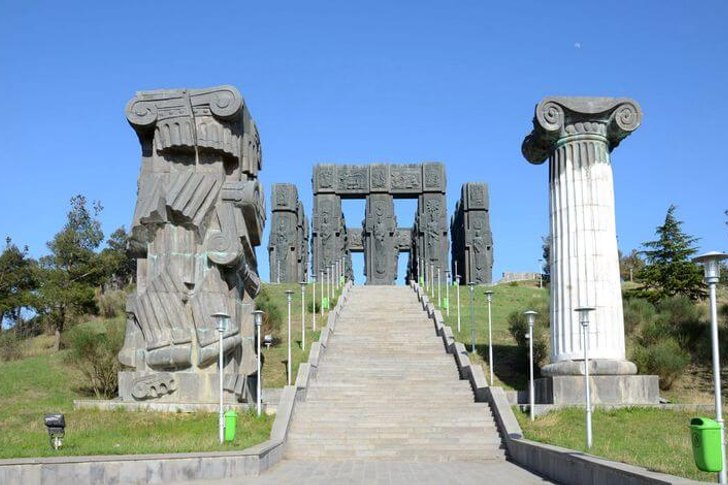
Tbilisi Botanical Garden
The park was laid out in the middle of the 19th century in the place where the gardens of Georgian kings were located - along the Legvta-Khevi River. After the territory was transferred to the jurisdiction of the Academy of Sciences, the planting area was significantly expanded. At the moment, the Botanical Garden covers an area of 128 hectares. Plant diversity is represented by several thousand species, which are collected from all over the world and from different regions of Georgia.
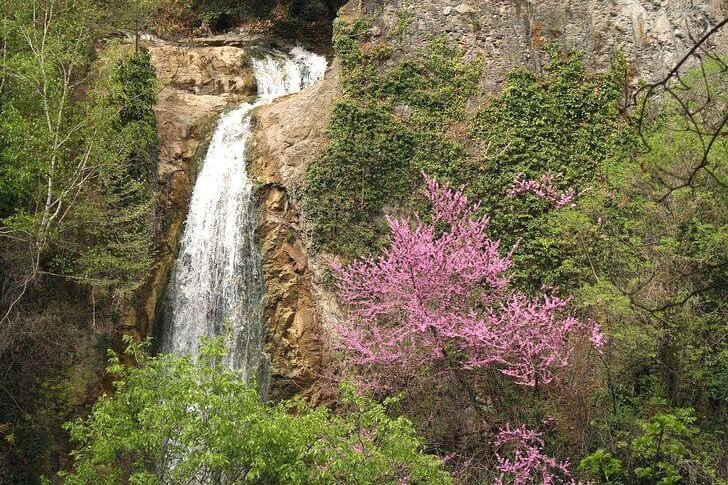
turtle lake
The reservoir is located on the northern slope of Mount Mtatsminda, about 3 km. from Tbilisi. Previously, turtles lived in these places, which is why the lake has such a name. For residents of the city, the reservoir is a popular place for outdoor recreation; quite a lot of people come here on weekends. Turtle Lake itself is small and deep, located at an altitude of 686 meters above sea level.
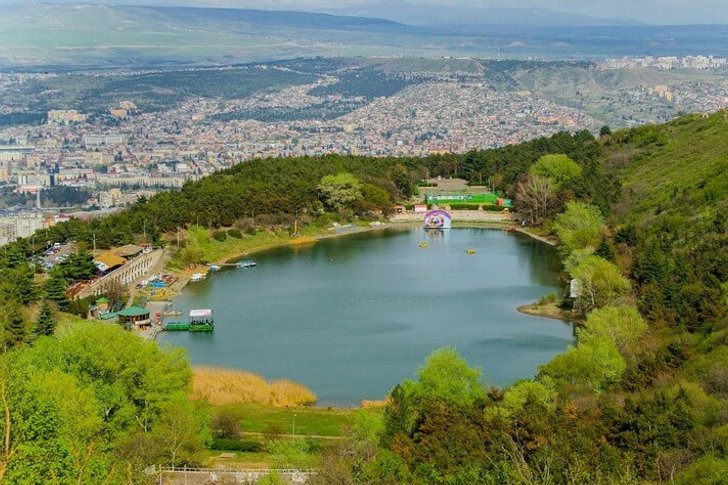
Rike Park
City park on the left bank of the Kura River, opened in 2010 next to the Peace Bridge. On its territory there are many entertainments for the whole family: children's labyrinths, a climbing wall for sports climbing, restaurants, a musical fountain. A grandiose futuristic building of the Theater of Music and Drama was built in the park, created in the form of a giant mirror tube, reminiscent of the powerful turbines of a spaceship.

Tbilisi funicular
The cable car connecting the city center with the park on Mount Mtatsminda. The system was built at the beginning of the 20th century by invited Belgian engineers. In 1990, a cable broke, resulting in the death of 15 people. In 2000, there was another incident with a cable break, after which the funicular stood abandoned until 2013. Now the renovated cable car is functioning again. On the way to the top, the funicular makes one stop at the Pantheon.
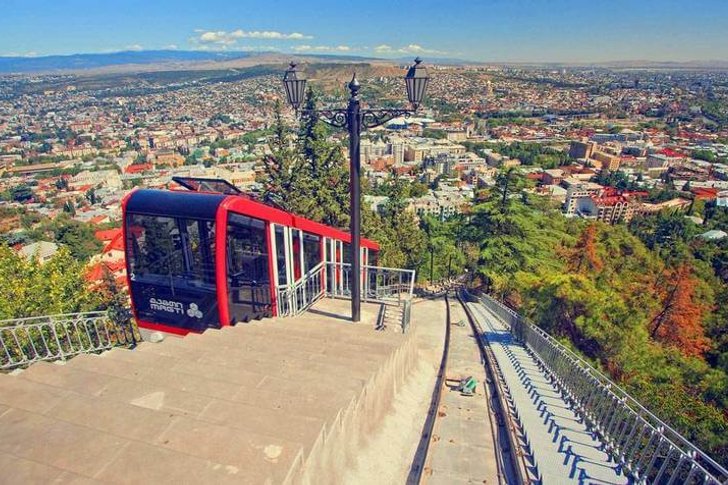
Amusement Park Mtatsminda
The park is located on top of the mountain of the same name. Since the 19th century, this place has gained popularity among the townspeople, numerous taverns have appeared here. In the 30s. XX century on the mountain was laid out square them. Stalin, which became the prototype of the modern amusement park. On the territory there are attractions, water slides, original sculptures, models of ancient castles, cafes and green recreation areas.

cable car
The cable car was built in 2012 and connects the Old Town with Narikala Fortress. The design is made taking into account the most stringent safety requirements. During the trip in glass-floored cabins, you can enjoy the picturesque views of Tbilisi right under your feet. The cable car quickly gained popularity among tourists and entered the list of the main sights of Tbilisi.
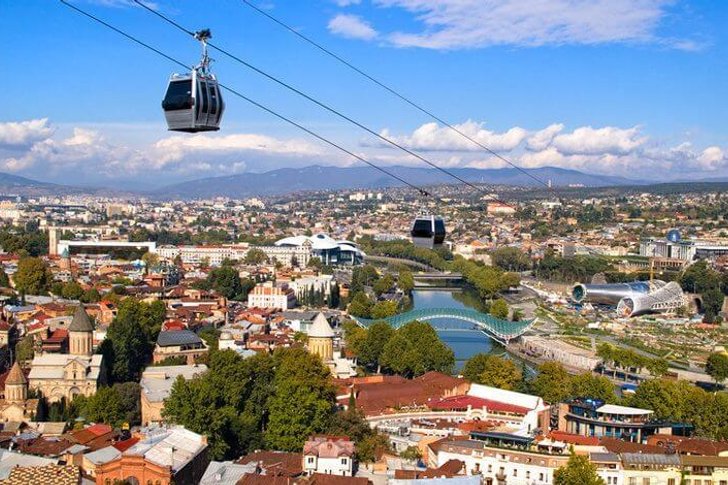
Peace Bridge
A modern bridge across the Kura River, built in 2010 according to the design of the Italian architect M. de Luca and lighting designer F. Martin. The construction connects the old and new parts of Tbilisi, symbolizing the transition from a glorious past to a promising future. The length of the bridge is 156 meters, the width is about 5 meters. The building is made in the style of "hi-tech". The bridge is equipped with a powerful illumination system and is covered with a glass dome resembling a fishing net.
